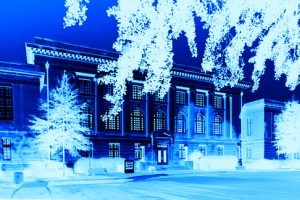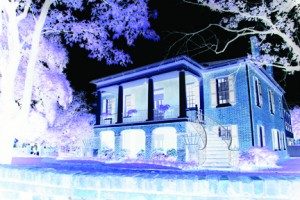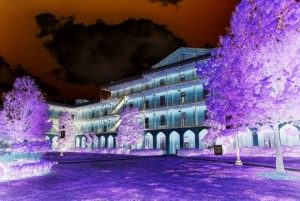Nearly 200 years old, scarred by civil war, shadowed by ancient trees, home to generations of students – surely such a place as The University of Alabama holds a treasure trove of lurid and ghastly ghost stories.
Not really, observed Dr. Jerry Oldshue, retired UA archivist and expert on campus history. Oldshue agreed to conduct a haunted tour of the Quad area for Halloween 2011, sponsored by the Alabama Museum of Natural History. Though not containing every purported haunted site on campus (Woods and Rowand-Johnson Halls both have ghosts), the Quad area is the locale for the handful of well-reported and oft-repeated stories.

The museum, housed in Smith Hall, was an appropriate starting and ending point for the tour. Named after Dr. Eugene Allen Smith, the hall contains not only scientific collections, but artifacts, photos and records from his time at the museum. Students and staff working late have reported hearing a professor – supposedly Smith – giving a lecture, and hearing footfalls and voices of students changing classes. But upon investigation, the classrooms are always empty. Others report feel they are watched as they work, as if a professor is peering over their shoulders. (Smith was known as a gentle, unselfish man, passionately dedicated to the University, to students and to the museum.)
Just as Smith was devoted to the University, so was Amelia Gayle Gorgas, wife of UA President Josiah Gorgas and a University legend in her own right. She was, among other things, first female librarian. Oldshue worked on the fourth floor of the library which bears her name. At 5 p.m. each day, the elevator to the fourth floor was locked.
“But not infrequently, as we were working late, the elevator would come to the fourth floor; the doors would open. No one was ever, ever on it when it did that. And it was the floor where Mrs. Gorgas’ belongings, such as her desk, were kept. We wondered if she was visiting her library,” Oldshue said.

Amelia Gorgas was a substitute mother to generations of homesick students, and a mother to her own family. After a busy day she would sit on the porch of Gorgas House, rocking and greeting passersby. Her daughters, who lived in the house after her, kept up the tradition of peaceful evenings rocking on the porch. By 1953, all the family had moved away or died. Yet witnesses said that on many evenings, the rocking chairs moved in companionable silence, as if their long-gone owners were still there.
Not far from the Gorgas House is the Mound, formed from debris of buildings burned in the April 1865 Union attack. The Mound is now used only for Honors Week ceremonies. Years ago, however, three people, at least one an administrator and one a professor, had their ashes spread upon the Mound, their last wish to be forever a part of the University. Oldshue related that on windy nights, three men can be glimpsed standing on the Mound, oddly transparent men. They can be seen, but can never be caught.

Not every spirit remains out of loyalty. Union soldiers, lured into a trap by University cadets who then killed them in the Round House, are still supposed to be heard within the building. On the other side of Gorgas Library from the Round House, a small set of bricks is all that is left of Madison Hall, burned in the Union raid. People have long reported that on the nights of April 3 and 4, when walking past that small ruin, they can smell smoke and hear the sounds of battle, as if coming from far away.
Is there anything to these stories? Elevators malfunction and rocking chairs rock when bumped. Small sounds magnify in empty halls, and moonlight plays tricks on the eyes. Stories get muddled or invented. (There is no evidence that any Union soldiers were killed in the Round House.)
But Gorgas and Smith certainly were real. Perhaps it is appropriate that of all the people who figure in our ghost stories the most well known would be faculty and staff, whose devotion to the Capstone was so legendary in life it was seen as continuing beyond the grave.